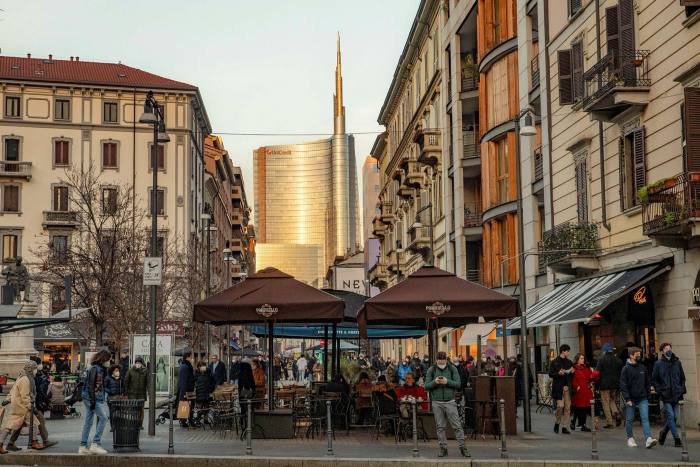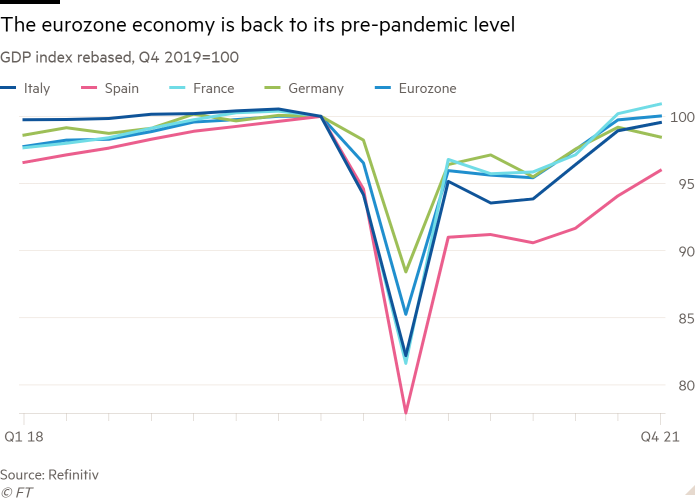[ad_1]
The eurozone economy grew 0.3 per cent in the final three months of last year, returning the bloc to its pre-pandemic level of output despite a sharp slowdown from the previous quarter as coronavirus infections hit record levels.
Fourth-quarter growth in the 19-country bloc was in line with the expectations of economists polled by Reuters, as it decelerated from 2.2 per cent growth in the previous three-month period. Household spending continued to grow in many countries, albeit at a slower pace, while output was also boosted by businesses restocking inventories.
Contractions of output in Germany and Austria were offset by quarter-on-quarter growth in countries including Spain, France and Italy, as the bloc showed increased resilience to the impact of the pandemic, which had plunged it into a record post-war recession in 2020.
Eurostat said on Monday that its first estimate of full-year gross domestic product showed growth of 5.2 per cent in both the eurozone and the wider EU for 2021 — the region’s fastest expansion since 1971, but slower than the US economy’s 5.7 per cent growth last year.
Economists calculated that the single currency area had rebounded to pre-pandemic levels of GDP.
Eurozone growth is expected to remain sluggish in the first few months of this year before economic activity picks up again as coronavirus restrictions are loosened and supply chain bottlenecks ease.
“Restrictions in many countries to counter the Omicron wave are set to be lifted soon, allowing the recovery to resume in the coming months,” said Jessica Hinds, senior Europe economist at Capital Economics.
Italy’s economy continued to beat expectations with growth of 0.6 per cent in the fourth quarter, leading to full-year growth of 6.4 per cent, according to figures published on Monday. It was the fastest annual expansion since at least 1995, according to Reuters. The growth was attributed to higher domestic demand driving increased output in industry and services.

UniCredit’s headquarters in Milan. Italy’s economy has rebounded more sharply than many economists initially expected © Francesca Volpi/Bloomberg
The eurozone’s third-largest economy has rebounded more sharply than many economists initially expected from its decline of almost 9 per cent in 2020 and is now close to returning to pre-pandemic levels of GDP.
“This confirms the country’s improved ability to recover from crisis compared to previous episodes,” said Loredana Maria Federico, chief Italian economist at UniCredit.
While the latest wave of Covid-19 cases has led to tighter restrictions that dented consumer spending and prolonged supply chain bottlenecks that have squeezed manufacturing, overall economic activity in Europe has been less disrupted than in previous waves.

The exception has been Germany, where the economy shrank 0.7 per cent in the fourth quarter, as a drop in consumer spending and supply constraints on manufacturing weighed on overall output.
The lacklustre performance of Europe’s largest economy left it 1.5 per cent below pre-pandemic levels of GDP. In contrast, the US economy was 3.1 per cent above its pre-pandemic level in the fourth quarter, while France was 0.9 per cent above pre- crisis GDP levels.
Spain achieved the fastest growth in the fourth quarter, expanding 2 per cent. But the country’s greater reliance on pandemic-hit tourism has weighed on its recovery and its GDP was still 4 per cent below pre-pandemic levels.
“There are a lot of country-specific drivers, not only more pandemic-related effects such as the timing of restrictions and supply chain problems but probably also how direct the hit was from high electricity prices,” said Daniel Bergvall, an economist at SEB .
Austria was one of the weakest eurozone economies in the fourth quarter, when its economy shrank 2.2 per cent after it imposed a lockdown to tackle soaring coronavirus infections. In contrast, Portugal had lighter curbs and its economy grew 1.6 per cent.
[ad_2]
Source link








